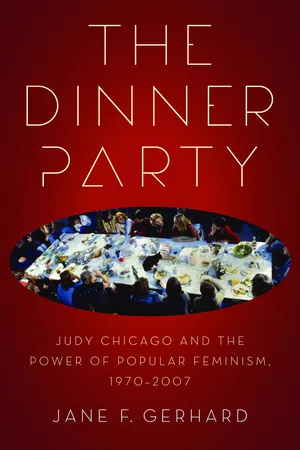
The Dinner Party
Judy Chicago and the Power of Popular Feminism, 1970-2007
- 360 pages
- English
- ePUB (mobile friendly)
- Available on iOS & Android
The Dinner Party
Judy Chicago and the Power of Popular Feminism, 1970-2007
About This Book
Judy Chicago's monumental art installation The Dinner Party was an immediate sensation when it debuted in 1979, and today it is considered the most popular work of art to emerge from the second-wave feminist movement. Jane F. Gerhard examines the piece's popularity to understand how ideas about feminism migrated from activist and intellectual circles into the American mainstream in the last three decades of the twentieth century.
More than most social movements, feminism was transmitted and understood through culture—art installations, Ms. Magazine, All in the Family, and thousands of other cultural artifacts. But the phenomenon of cultural feminism came under extraordinary criticism in the late 1970s and 1980s Gerhard analyzes these divisions over whether cultural feminism was sufficiently activist in light of the shifting line separating liberalism from radicalism in post-1970s America. She concludes with a chapter on the 1990s, when The Dinner Party emerged as a target in political struggles over public funding for the arts, even as academic feminists denounced the piece for its alleged essentialism.
The path that The Dinner Party traveled—from inception (1973) to completion (1979) to tour (1979-1989) to the permanent collection of the Brooklyn Museum (2007)—sheds light on the history of American feminism since 1970 and on the ways popular feminism in particular can illuminate important trends and transformations in the broader culture.
Frequently asked questions
Information
Notes
INTRODUCTION
Table of contents
- Cover Page
- Title Page
- Copyright Page
- Contents
- Acknowledgments
- Introduction Toward a Cultural History of The Dinner Party
- One Making Feminist Artists: The Feminist Art Programs of Fresno and CalArts, 1970–1972
- Two Making Feminist Art: Womanhouse and the Feminist Art Movement, 1972–1974
- Three The Studio as a Feminist Space: Practicing Feminism at The Dinner Party, 1975–1979
- Four Joining Forces: Making Art and History at The Dinner Party, 1975–1979
- Five Going Public: The Dinner Party in San Francisco, 1979
- Six The Tour That Very Nearly Wasn’t: The Dinner Party’s Alternative Showings, 1980–1983
- Seven Debating Feminist Art: The Dinner Party in Published and Unpublished Commentary, 1979–1989
- Eight From Controversy to Canonization: The Dinner Party in the Culture Wars, 1990–2007
- Epilogue A Prehistory of Postfeminism
- Notes
- Index